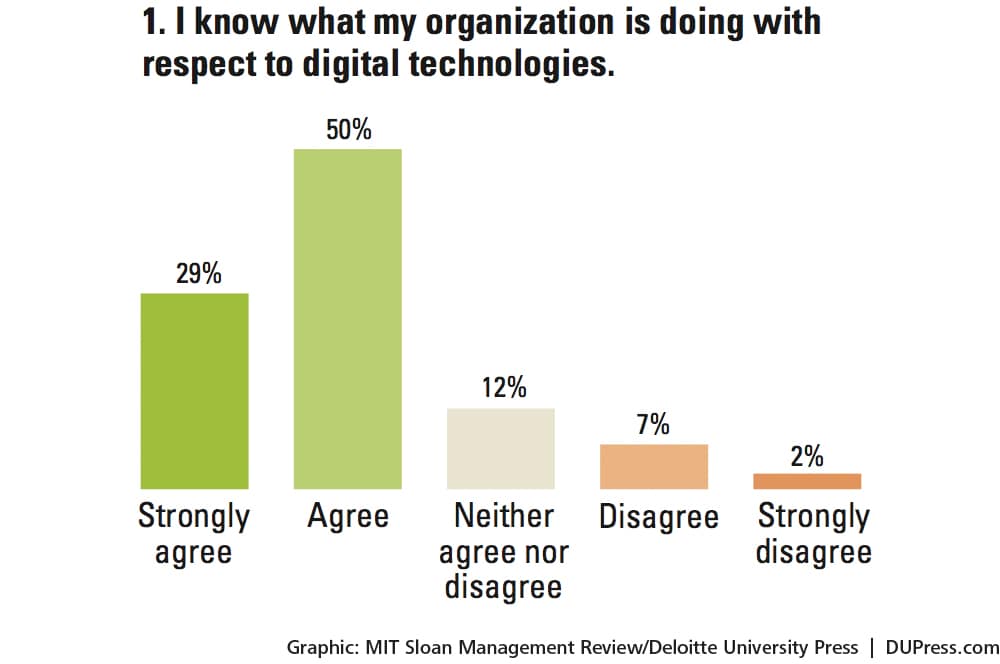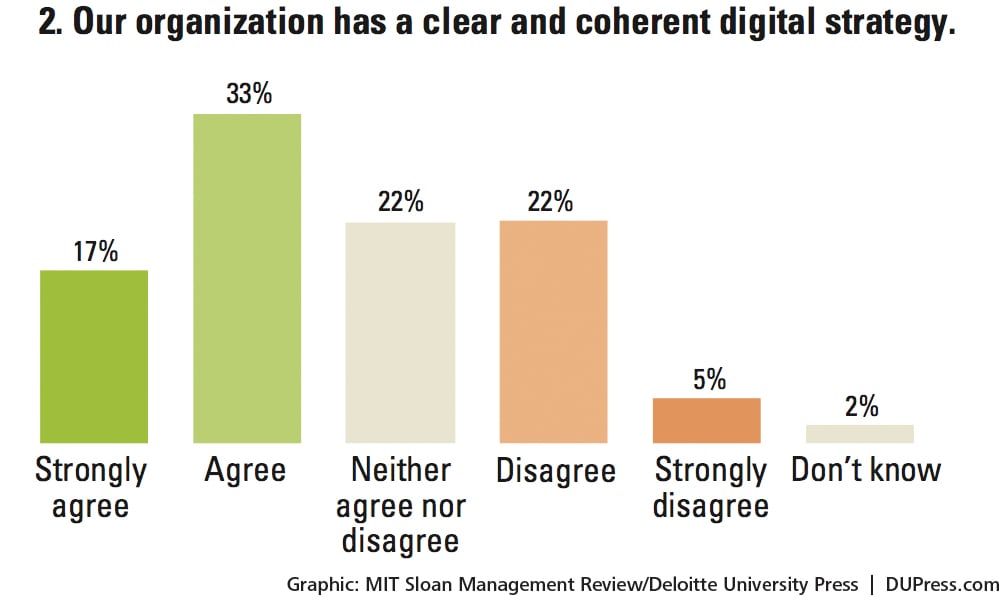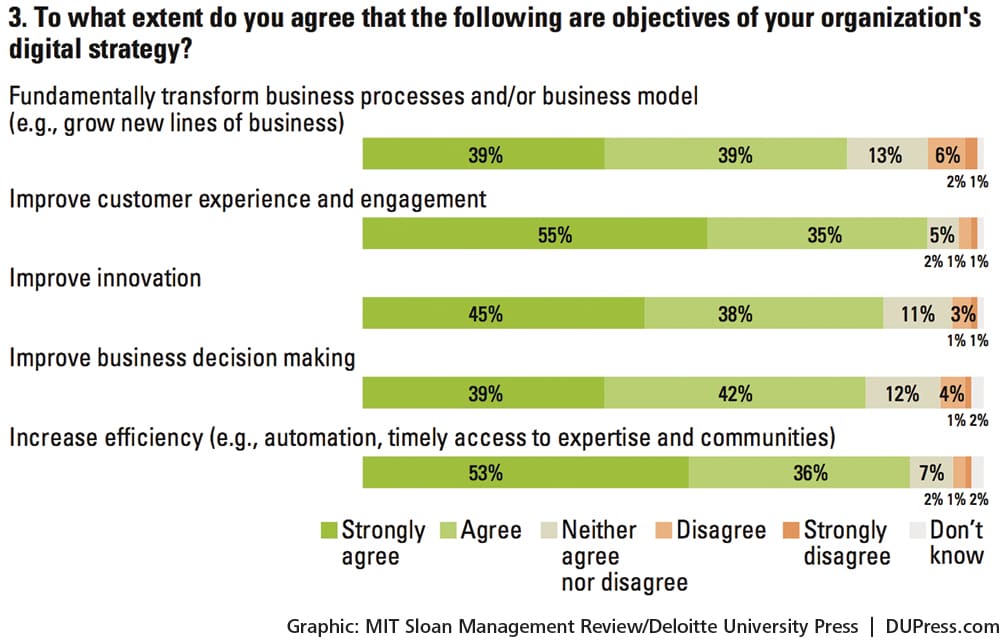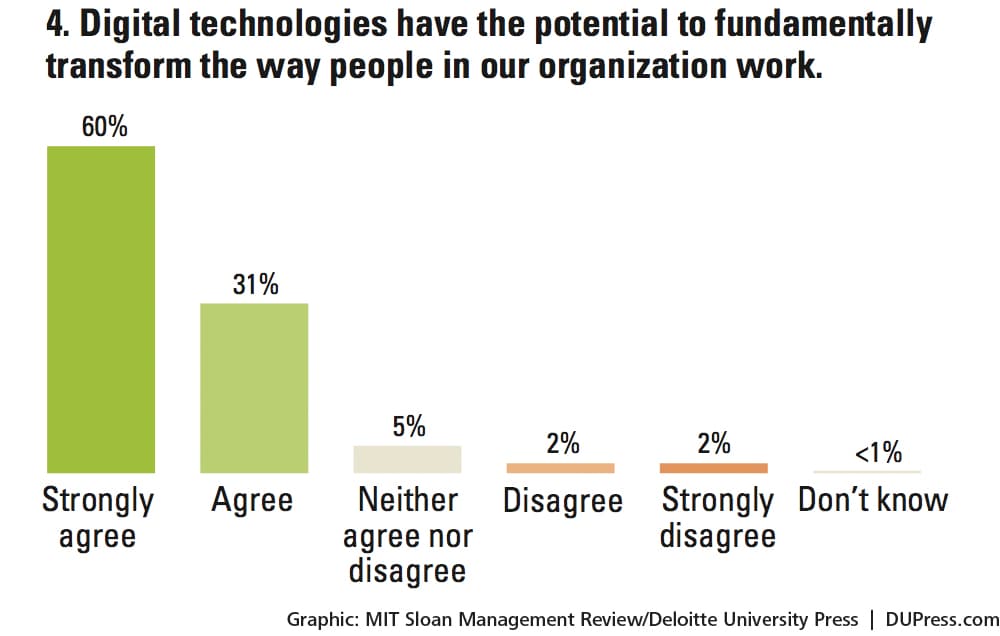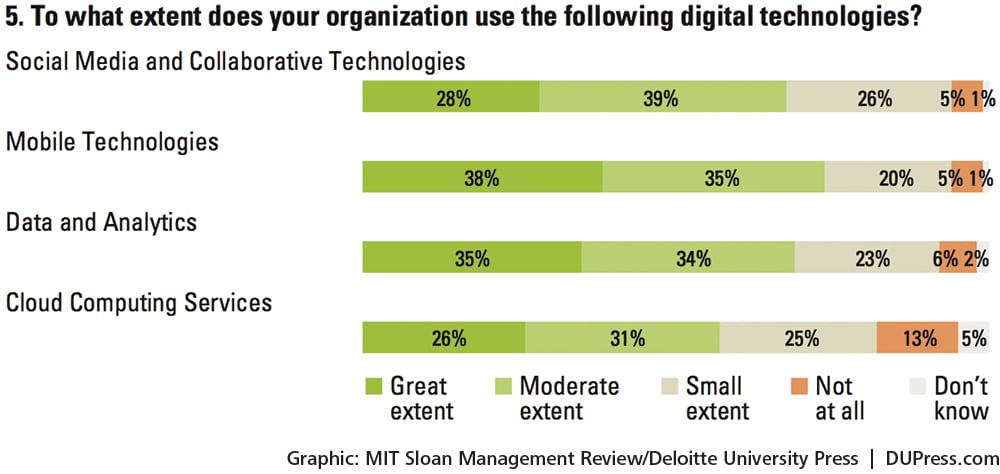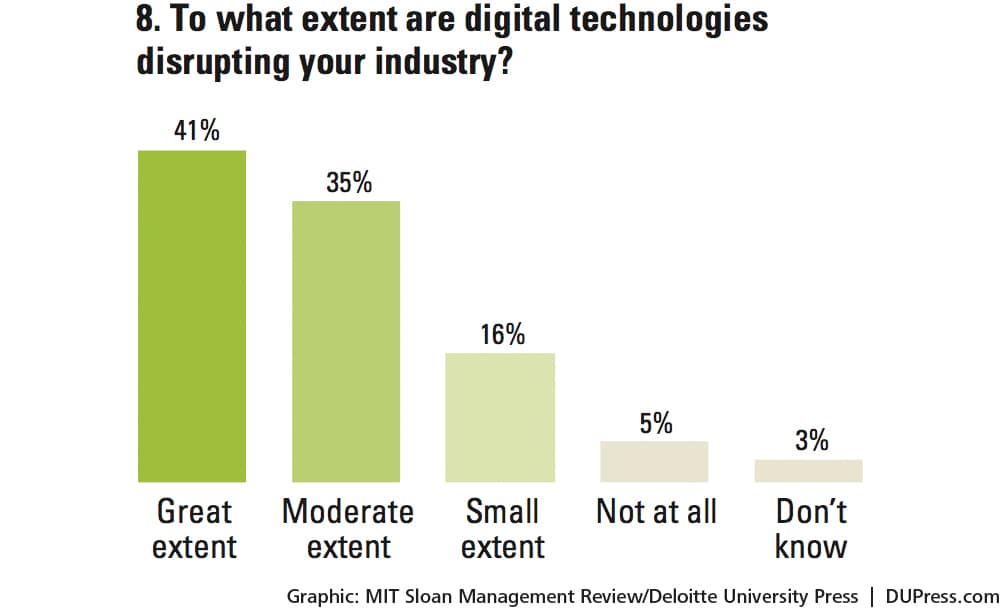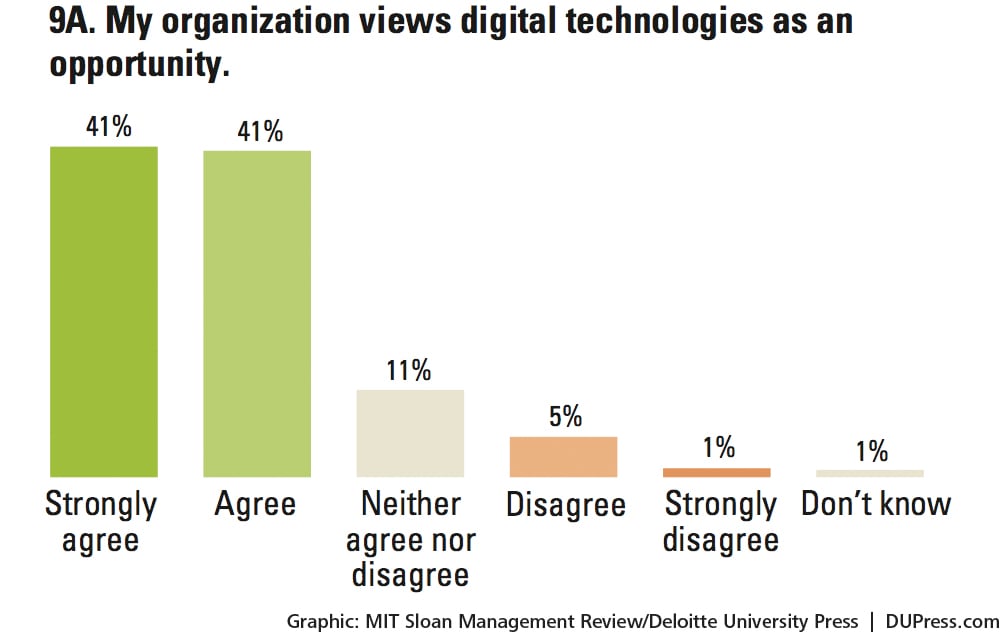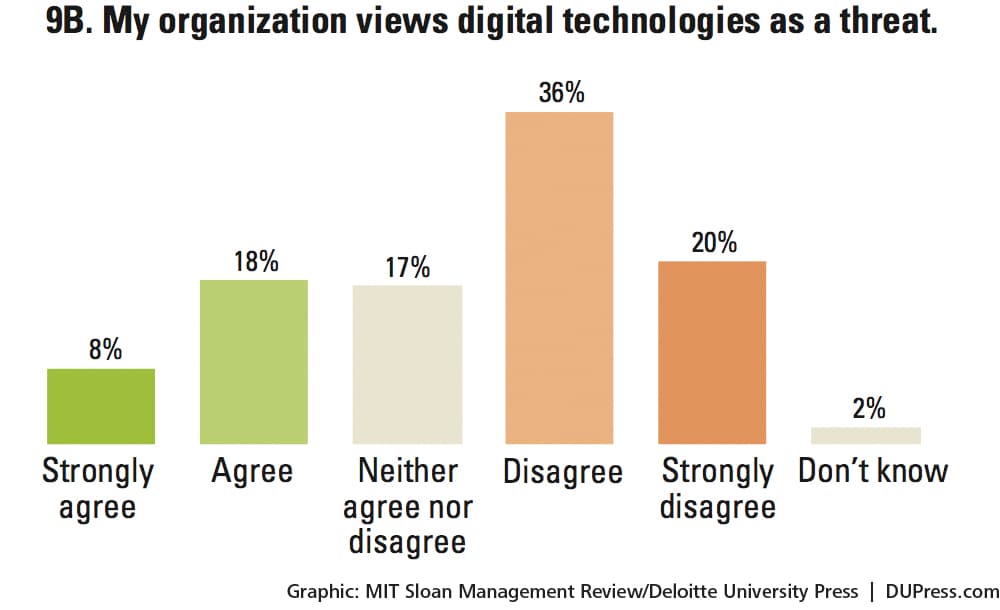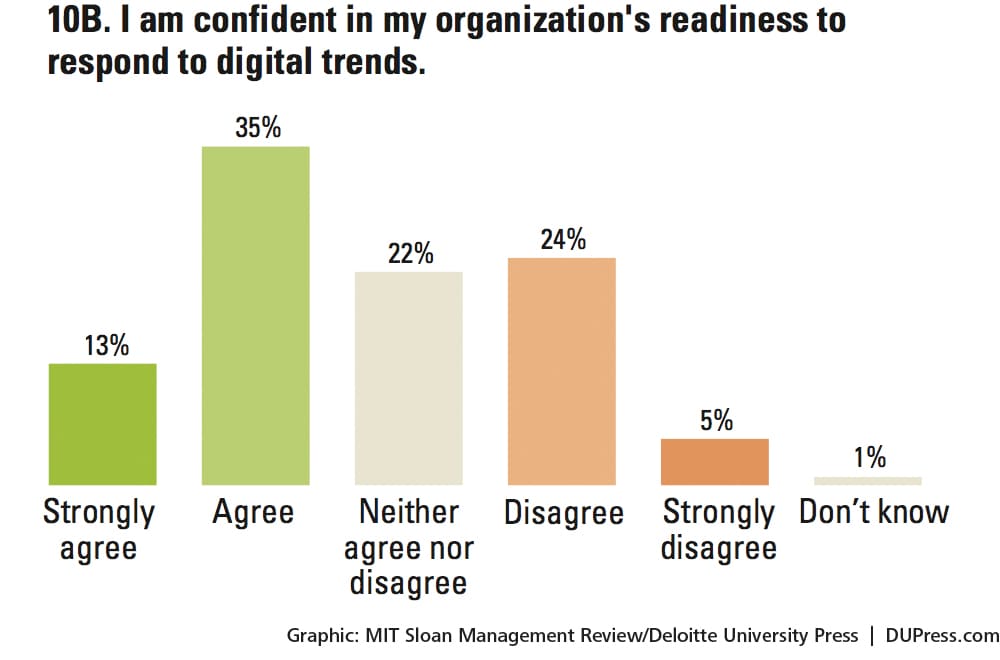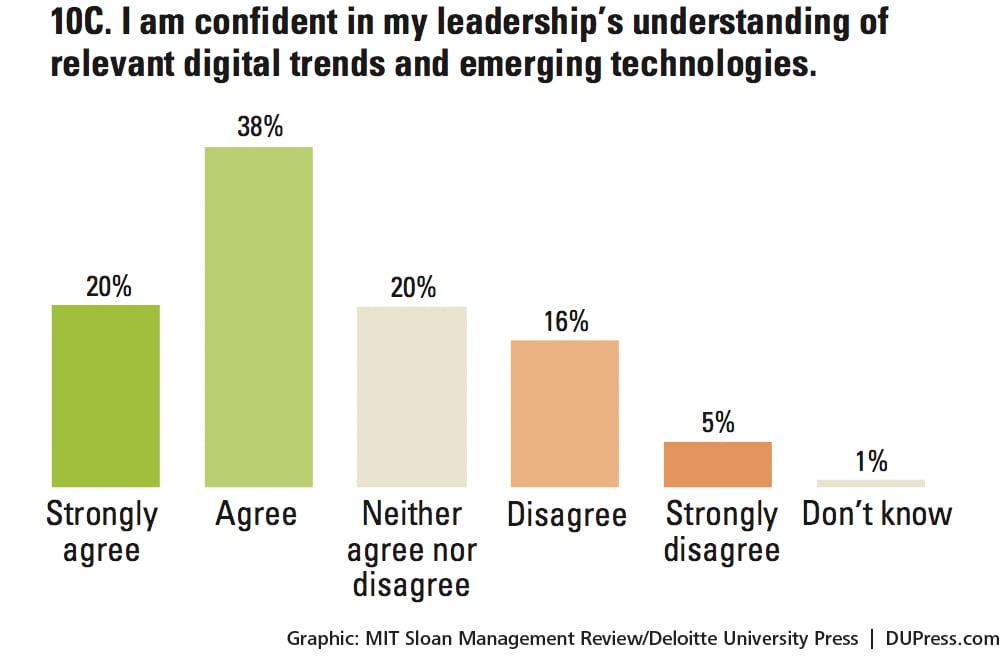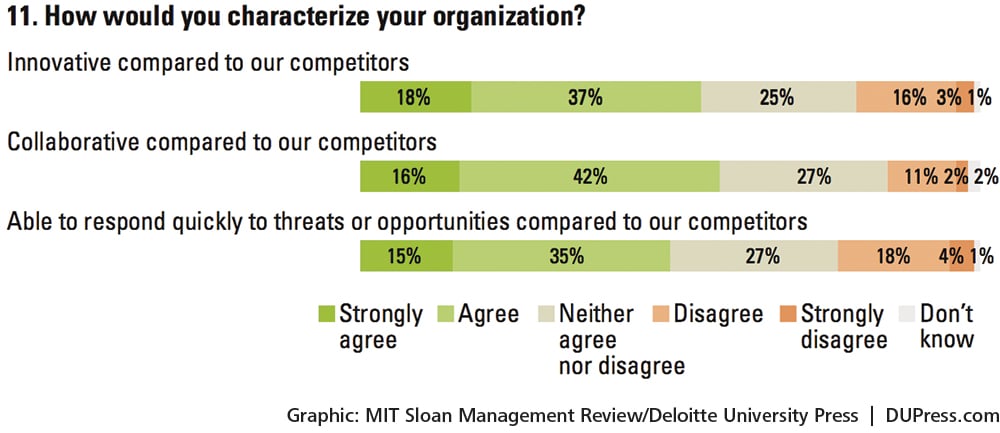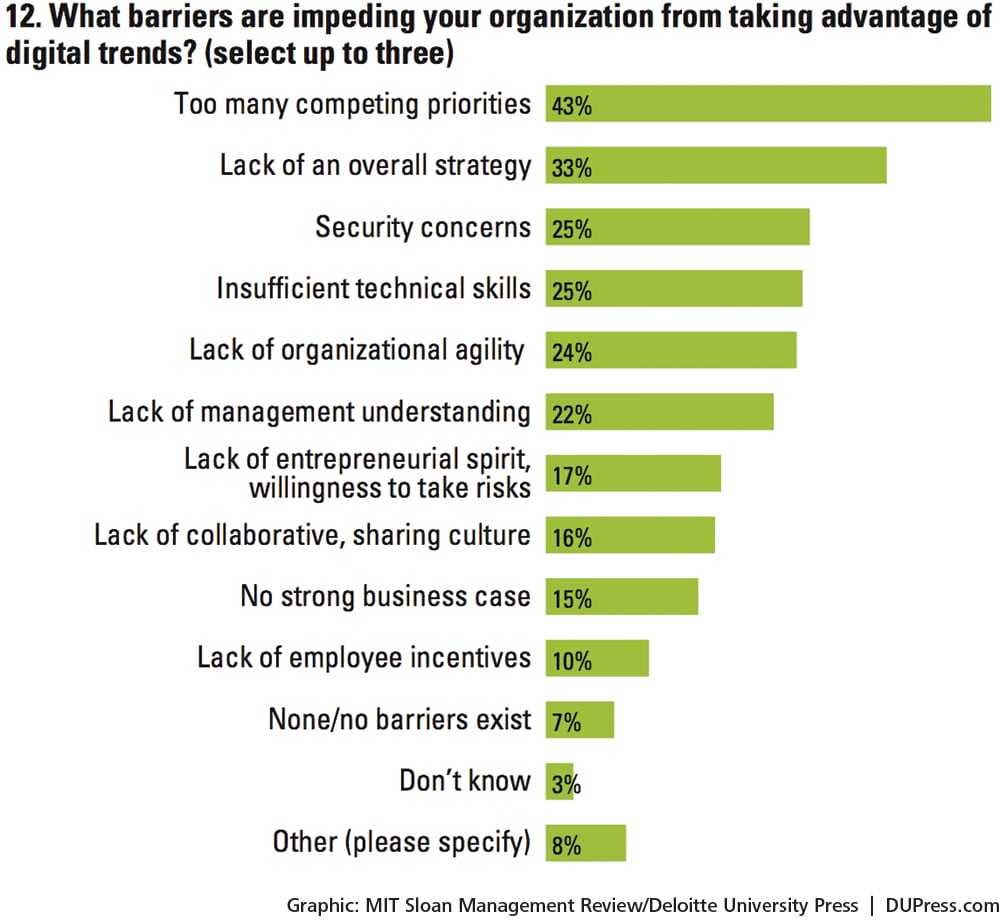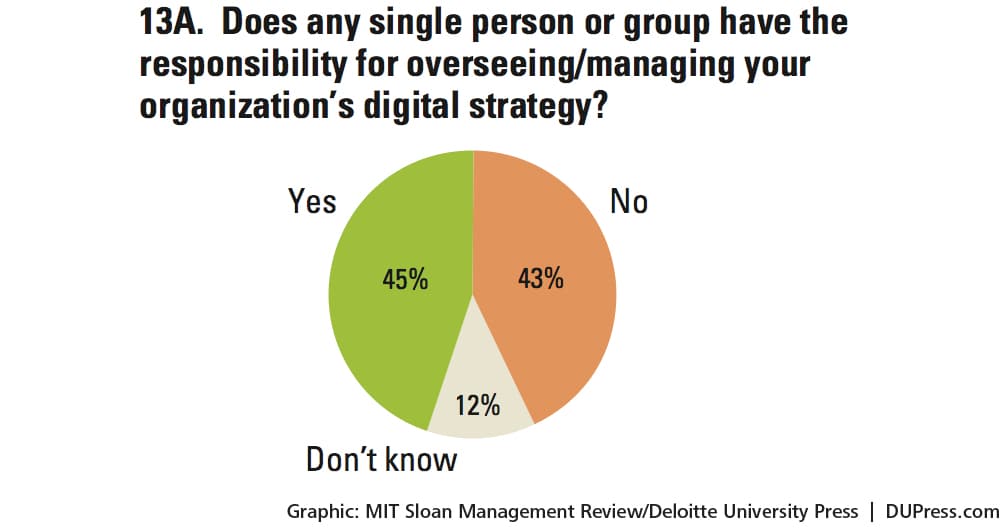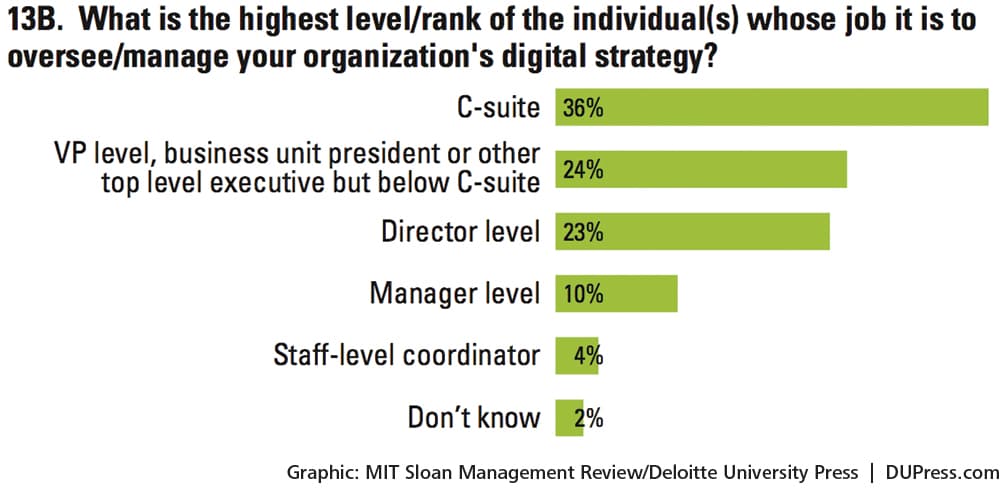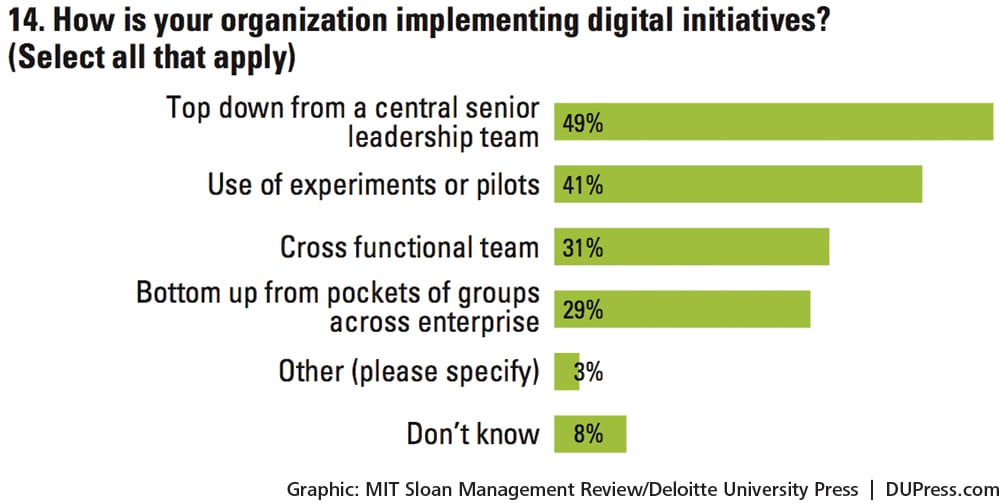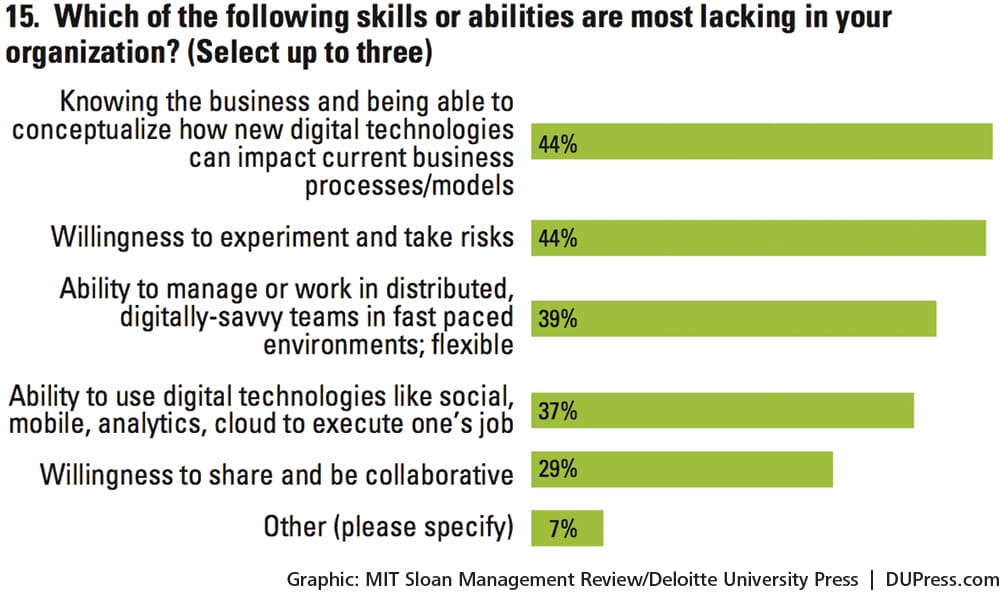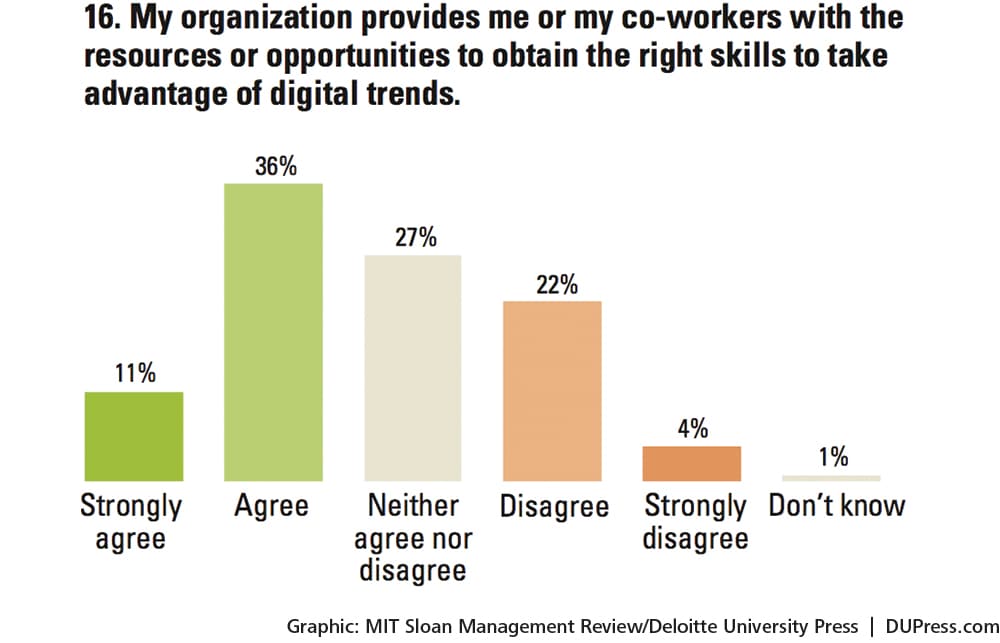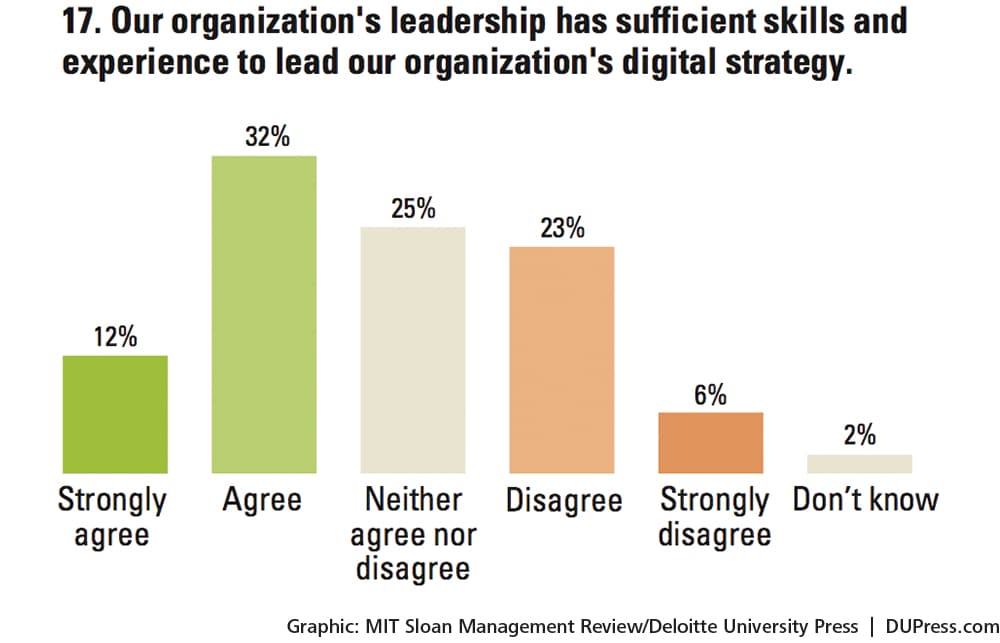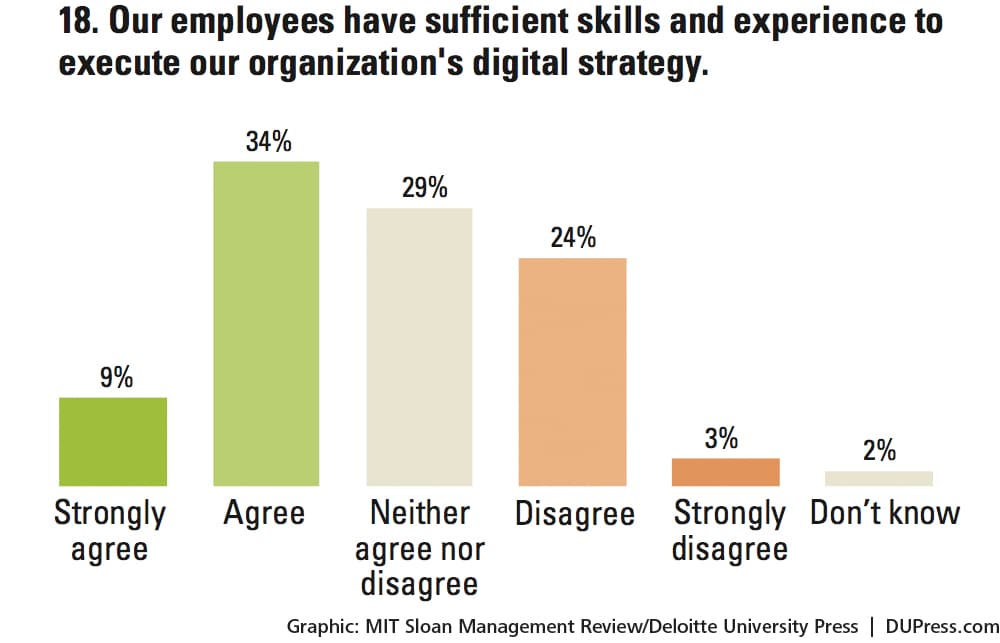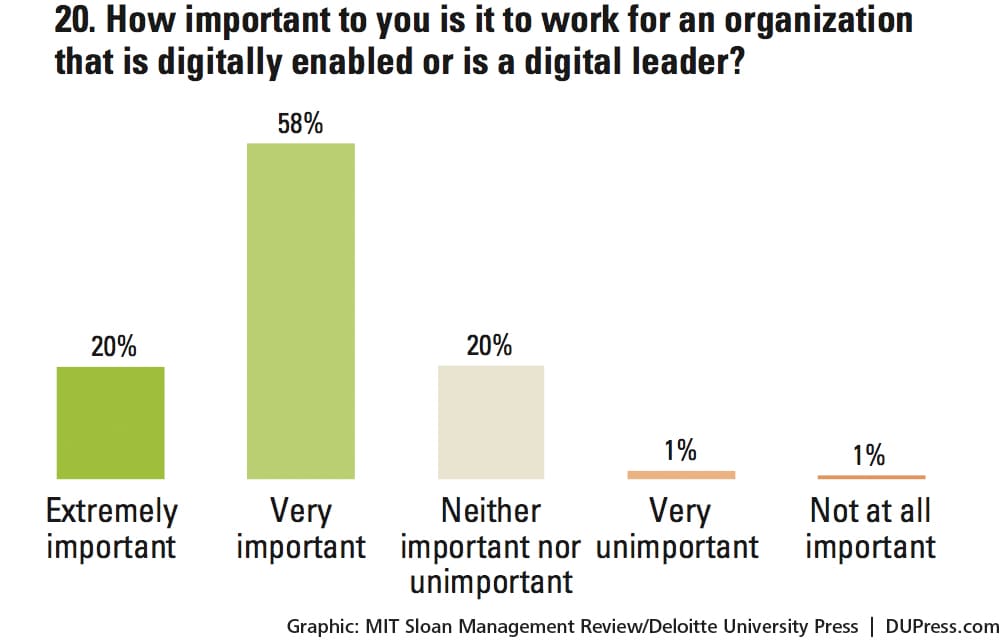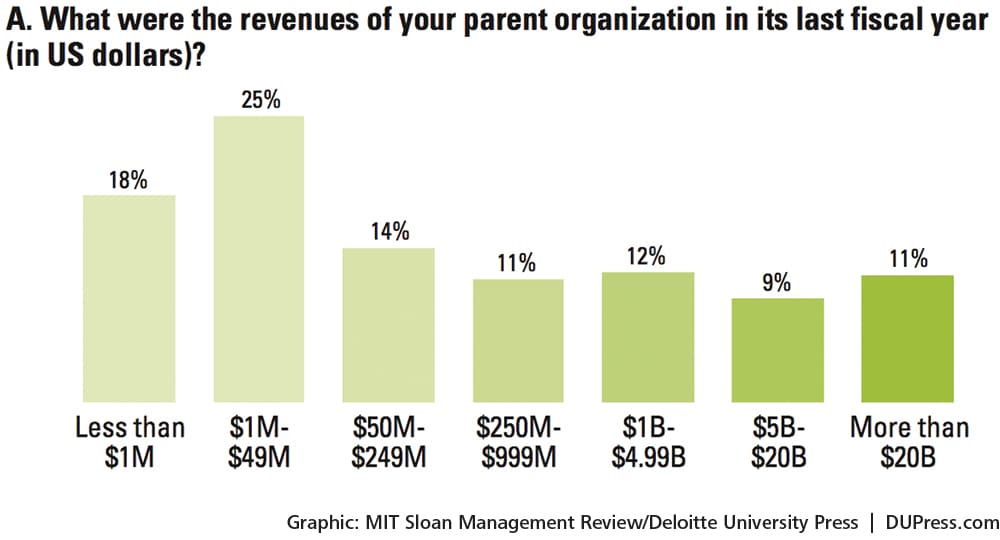Strategy, not technology, drives digital transformation has been saved

Strategy, not technology, drives digital transformation Becoming a digitally mature enterprise
15 July 2015
What’s the most important driver of organizational digital maturity—social, mobile, analytics, or cloud? None of the above, according to the latest MIT Sloan Management Review and Deloitte digital business study.
We’re kicking off our fifth annual research study with MIT Sloan Management Review. Help us understand the impact of social and digital disruption on organizations. Participate in the survey now!
See the related infographic and listen to the podcast. View an interactive dashboard of the 2015 study data, categorized by industry.
About the research
To understand the challenges and opportunities associated with the use of social and digital business, MIT Sloan Management Review, in collaboration with Deloitte, conducted its fourth annual survey of more than 4,800 business executives, managers and analysts from organizations around the world. The survey, conducted in the fall of 2014, captured insights from individuals in 129 countries and 27 industries and involved organizations of various sizes. The sample was drawn from a number of sources, including MIT alumni, MIT Sloan Management Review subscribers, Deloitte Dbriefs webcast subscribers and other interested parties. In addition to our survey results, we interviewed business executives from a number of industries, as well as technology vendors, to understand the practical issues facing organizations today. Their insights contributed to a richer understanding of the data. Surveys in the three previous years were conducted with a focus on social business. This year’s study has expanded to include digital business.
Executive Summary
MIT Sloan Management Review and Deloitte’s1 2015 global study of digital business found that maturing digital businesses are focused on integrating digital technologies, such as social, mobile, analytics and cloud, in the service of transforming how their businesses work. Less-mature digital businesses are focused on solving discrete business problems with individual digital technologies.
Join the conversation
Follow #digitalevolution on social mediaThe ability to digitally reimagine the business is determined in large part by a clear digital strategy supported by leaders who foster a culture able to change and invent the new. While these insights are consistent with prior technology evolutions, what is unique to digital transformation is that risk taking is becoming a cultural norm as more digitally advanced companies seek new levels of competitive advantage. Equally important, employees across all age groups want to work for businesses that are deeply committed to digital progress. Company leaders need to bear this in mind in order to attract and retain the best talent.
The following are highlights of our findings:
Digital strategy drives digital maturity. Only 15% of respondents from companies at the early stages of what we call digital maturity — an organization where digital has transformed processes, talent engagement and business models — say that their organizations have a clear and coherent digital strategy. Among the digitally maturing, more than 80% do.
The power of a digital transformation strategy lies in its scope and objectives. Less digitally mature organizations tend to focus on individual technologies and have strategies that are decidedly operational in focus. Digital strategies in the most mature organizations are developed with an eye on transforming the business.
Maturing digital organizations build skills to realize the strategy. Digitally maturing organizations are four times more likely to provide employees with needed skills than are organizations at lower ends of the spectrum. Consistent with our overall findings, the ability to conceptualize how digital technologies can impact the business is a skill lacking in many companies at the early stages of digital maturity.
Employees want to work for digital leaders. Across age groups from 22 to 60, the vast majority of respondents want to work for digitally enabled organizations. Employees will be on the lookout for the best digital opportunities, and businesses will have to continually up their digital game to retain and attract them.
Taking risks becomes a cultural norm. Digitally maturing organizations are more comfortable taking risks than their less digitally mature peers. To make their organizations less risk averse, business leaders have to embrace failure as a prerequisite for success. They must also address the likelihood that employees may be just as risk averse as their managers and will need support to become bolder.
The digital agenda is led from the top. Maturing organizations are nearly twice as likely as less digitally mature entities to have a single person or group leading the effort. In addition, employees in digitally maturing organizations are highly confident in their leaders’ digital fluency. Digital fluency, however, doesn’t demand mastery of the technologies. Instead, it requires the ability to articulate the value of digital technologies to the organization’s future.
Introduction: Digital Transformation Isn’t Really About Technology
One wouldn’t expect that changing the size of tables in an employee cafeteria could be emblematic of the digital transformation of a business. But consider this example: The tables in question were in the offices of a large, online travel company working with Humanyze, a people-analytics company headquartered in Boston that is a spinoff of the MIT Media Lab. Humanyze integrates wearables, sensors, digital data and analytics to identify who talks to whom, where they spend time and how they talk to each other. The analysis identifies patterns of collaboration that correlate with high employee productivity.
Humanyze analyzed the travel company’s workforce and discovered that people eating lunch together shared important insights that made them more productive. In addition, the analysis showed that productivity went up based on the number of people at the same table. At the company being analyzed, Humanyze found that employees typically lunched with either four or 12 people. A quick inspection of the cafeteria solved the puzzle — all the tables were for either four or 12 people. The integration of digital technologies pointed the way to increasing table sizes, which had a direct and measurable impact on employees’ ability to produce.
The tale of the tables is a powerful example of a key finding in this year’s MIT Sloan Management Review and Deloitte digital business study: The strength of digital technologies — social, mobile, analytics and cloud — doesn’t lie in the technologies individually. Instead, it stems from how companies integrate them to transform their businesses and how they work.
Another key finding: What separates digital leaders from the rest is a clear digital strategy combined with a culture and leadership poised to drive the transformation. The history of technological advance in business is littered with examples of companies focusing on technologies without investing in organizational capabilities that ensure their impact. In many companies, the failed implementation of enterprise resource planning and previous generations of knowledge management systems are classic examples of expectations falling short because organizations didn’t change mindsets and processes or build cultures that fostered change. Our report last year on social business found similar shortcomings standing in the way of technology reaching its potential.2
Our findings this year are based on an assessment of digital business maturity and how maturing organizations differ from others. To assess maturity, we asked respondents to “imagine an ideal organization transformed by digital technologies and capabilities that improve processes, engage talent across the organization and drive new value-generating business models.” (See “About the research” sidebar) We then asked them to rate their company against that ideal on a scale of 1 to 10. Three groups emerged: “early” (26%), “developing” (45%) and “maturing” (29%). (See Figure 1.)
Although we found some differences in technology use between different levels of maturity, we found that as organizations mature, they develop the four technologies (social, mobile, analytics and cloud) in near equal measure. The greatest differences between levels of maturity lie in the business aspects of the organization. Digitally maturing companies, for example, are more than five times more likely to have a clear digital strategy than are companies in early stages. Digitally maturing organizations are also much more likely to have collaborative cultures that encourage risk taking.
Several obstacles stand in the way of digital maturity; lack of strategy and competing priorities lead the list of speed bumps. Lack of a digital strategy is the biggest barrier to digital maturity for companies in the early stages, according to more than 50% of respondents from early-stage organizations. As companies move up the maturity curve, competing priorities and concerns over digital security become the primary obstacles. (See Figure 2.)
Across the board, respondents agree that the digital age is upon us: Fully 76% of respondents say that digital technologies are important to their organizations today, and 92% say they will be important three years from now. In this year’s report, which is based on a survey of more than 4,800 executives and managers as well as interviews with business and thought leaders, we look specifically at the emerging contours of digital business and how companies are moving forward with their digital transformations.
Digital Strategies That Transform
To a great extent, digital strategy drives digital maturity. Only 15% of respondents from companies at the early stages say that their organizations have a clear and coherent digital strategy. (See Figure 3.) Among the more digitally mature, the number leaps to 81%. Effectively communicating strategy is equally important, and maturing companies excel at it. Among respondents from companies at early stages, 63% agree or strongly agree that they know what their companies are doing in the digital domain. In maturing organizations, 90% do.
The ultimate power of a digital strategy lies in its scope and objectives. In his oft-cited 2003 Harvard Business Review article, “IT Doesn’t Matter,” Nicholas Carr argued that unless a technology is proprietary to a company, it ultimately won’t provide competitive advantage on its own. As was the case with electricity and rail transport, many technologies will become available to all and thus provide no inherent advantage. The trap to avoid, according to Carr, is focusing on technology as an end in itself. Instead, technology should be a means to strategically potent ends.3
Our research found that early-stage companies are falling into the trap of focusing on technology over strategy. Digital strategies at early-stage entities have a decidedly operational focus. Approximately 80% of respondents from these companies say improving efficiency and customer experiences are objectives of their digital strategies. Only 52% say that transforming the business is on the digital docket.
In maturing companies, on the other hand, digital technologies are more clearly being used to achieve strategic ends. Nearly 90% of respondents say that business transformation is a directive of their digital strategies. The importance that these organizations place on using digital technology to improve innovation and decision making also reflects a broad scope beyond the technologies themselves. In companies with low digital maturity, approximately 60% of respondents say that improving innovation and decision making are digital strategy objectives. In digitally maturing organizations, nearly 90% of strategies focus on improving decisions and innovation. (See Figure 4.)
“Senior leadership must really understand the power of digital technologies,” says Carlos Dominguez, president and COO of Sprinklr, an enterprise social technology provider. “This is as much a transformation story as it is a technology one.”
Creating a Strategy That Transforms
When developing a more advanced digital strategy, the best approach may be to turn the traditional strategy development process on its head. Benn Konsynski, the George S. Craft Distinguished University Professor of Information Systems & Operations Management at Emory University’s Goizueta Business School, proposes that rather than analyzing current capabilities and then plotting an organization’s next steps, organizations should work backwards from a future vision.
A Digital McDonald's
As it confronts changing consumer tastes, McDonald’s is digitally revamping its restaurant experience and how the company works. The global restaurant chain was one of the first companies to adopt the Apple Pay mobile payments solution. Last year, it installed kiosks in select locations that allow customers to order customized hamburgers. And it’s seeking partnerships with startups, such as a company that embeds sensors into paper.4
McDonald’s is also integrating digital technologies to spur the organization to work in new ways. Its ambitious campaign during the 2015 Super Bowl football championship is an excellent example: McDonald’s planned to give away an item related to every commercial that aired during the game.
To respond to commercials almost instantaneously, McDonald’s had to integrate multiple digital technologies and reconfigure its internal communication and operational processes. The integration came together in a digital newsroom with a cross-functional team that included members from the company’s marketing and legal divisions, representatives from the company’s various advertising agencies and employees from the company’s enterprise social technology provider.
Meeting the goal required real-time reactions and monitoring and analysis of social media trends. It also demanded on-the-spot decision making to come up with the best decisions about which products to give away. The effort was successful and drew 1.2 million retweets, including some from high-profile celebrities such as Taylor Swift.
The event was part of an ongoing effort at the fast food chain to transform itself into an organization that integrates technologies to become more agile, experimental and collaborative. As Lainey Garcia, manager of brand public relations and engagement at McDonald’s, put it: “The biggest takeaway was the power of integration. You can accomplish amazing things when you have all those pieces working together collectively in a holistic way.”
“The future is best seen with a running start,” Konsynski comments. “Ten years ago, we would not have predicted some of the revolutions in social or analytics by looking at these technologies as they existed at the time. I would rather start by rethinking business and commerce and then work backwards. New capabilities make new solutions possible, and needed solutions stimulate demand for new capabilities.”
As an example, Konsynski points to the spice and flavor manufacturer McCormick & Company. Given the importance of personalization and digital technology’s ability to provide it, McCormick developed FlavorPrint, an algorithm representing the company’s flavors as a vector of 50 data points. Currently, McCormick uses FlavorPrint to recommend recipes to its consumers. But the vision is much bolder. McCormick thinks of FlavorPrint as the Pandora of flavorings, which has prompted the organization to see itself as a food experience company rather than a purveyor of spices.
Eventually, all McCormick flavors will be digitized, and the company will be able to tailor them to regional, cultural and even individual personal tastes. Although all the needed technologies are not yet available, they likely will be in the coming years, and the strategy to take advantage of them is already in place. The FlavorPrint product has shown such promise that McCormick recently spun it off into its own technology company, Vivanda, with former McCormick CIO Jerry Wolfe as its founder and CEO.5
The Talent Challenge
Maturing digital organizations don’t tolerate skill gaps. More than 75% of respondents from these companies agree or strongly agree that their organizations are able to build the necessary skills to capitalize on digital trends. Among low-maturity entities, the number plummets to 19%.
Consistent with our overall findings, the ability to conceptualize how digital technologies can impact the business is a skill lacking in early-stage companies. Nearly 60% of respondents from these organizations rank ability to conceptualize as one of the top three skills that need bolstering. Only 32% of respondents from digitally maturing companies express the same need.
The ability to adapt quickly to change also stands out as an important capability. Perry Hewitt, chief digital officer at Harvard University, says agility is more important than technology skills. Emory professor Konsynski concurs: “The 21st century is about agility, adjustment, adaptation and creating new opportunities.”
Training to fill skill gaps is increasingly offered online and on a just-in-time basis. As part of its new approach to learning, The Walt Disney Co., for example, has implemented a platform that offers video, mobile and digital content to employees as needed. “Three or four years ago, learning at Disney happened in classrooms,” says Steve Milovich, senior vice president of global human resources and talent diversity, Disney/ABC Television Group and also senior vice president of employee digital media, The Walt Disney Company. “Now we offer content such as TED-like talks featuring Disney executives that allow employees to seek knowledge when and how they need it.”
Just as important as developing talent is reducing the risk of losing it. On average, nearly 80% of respondents say they want to work for a digitally enabled company or digital leader. The sentiment crosses all age groups, from 22 to 60, nearly equally. “The myth is that digital technology is a young person’s game,” says Scott Monty, the former executive vice president of strategy at Shift Communications, now principal at Scott Monty Strategies. “At one point, women over 55 represented the fastest-growing Facebook demographic. This is about how humans interact, not just about how Millennials do.” (See Figure 5.)
Employees of all ages are on the lookout for the best digital companies and opportunities. Many respondents from our research are not merely indifferent to their company’s current reaction to digital trends, they are dissatisfied. (See Figure 6.) Businesses need to make sure they are engaging employees in service of the organization’s digital aims. That engagement is the function of two critical components of strategy execution: culture and leadership.
The Culture of Digital Business Transformation
A culture conducive to digital transformation is a hallmark of maturing companies. These organizations have a strong propensity to encourage risk taking, foster innovation and develop collaborative work environments. “Culture needs to support collaboration and creativity,” says Mohamed-Hédi Charki, an associate professor at EDHEC Business School in France who focuses on the outcomes associated with the implications of an enterprise social network at a European cosmetics company. “In this fast-changing, complex world, if a company sees innovation as something incremental, it will be marginalized in the coming years.”
Industry Lens: Leaders, but no Laggards
Industries born of technology lead the list of sectors with the greatest penetration of digitally maturing organizations — IT, telecom, and media & entertainment. However, this year’s digital business study did not find a consistent set of laggards on the opposite end of the spectrum. Companies in each sector have strengths to build on as well as weaknesses to address.
The construction and real estate sector, for example, ranks lowest in terms of digital maturity — defined as an organization where digital has transformed processes, talent engagement and business models — but ranks in the top five industries reaping digital gains by improving work with partners and employees.
Companies in this sector also lag in the development of digital strategies focused on transforming their businesses.Consumer goods companies sit squarely in the middle of the digital maturity spectrum but fall short on digitally enabling employees. Conversely, the manufacturing sector is providing digital skills to employees but has yet to realize digital gains. The issue may be that executives in the sector need to increase their efforts to encourage employees to use digital technologies to innovate.
Taking Risks Becomes a Cultural Norm
Digitally maturing organizations are considerably less risk averse than their peers. More than half of respondents from less digitally mature companies see their organization’s fear of risk as a major shortcoming. In maturing entities, only 36% register the same complaint.
Phil Simon, author of several books on how technology impacts business, sees risk aversion as a serious impediment that plagues many established companies. “For every Google, Amazon or Facebook taking major risks, hundreds of large companies are still playing it safe,” he says. “Today, the costs of inaction almost always exceed the costs of action.”
Making a culture less risk averse is by no means an insurmountable task. To boost risk taking in their companies, executives need to change their mindsets. Dr. John Halamka, chief information officer of the Boston health care provider Beth Israel Deaconess Medical Center, says that leaders must acknowledge failure as a prerequisite for success. “Failure is a valid outcome,” he says. “Wearable computing is great, but Google Glass wearable computing devices turned out not to be for us right now. We may discover that patients love the Apple Watch wrist-wearable device and it becomes a platform. It’s hard to know. But even if it doesn’t, it’s OK.”
Cisco CEO John Chambers echoes the sentiment. “We began working on the Internet of everything more than seven years ago,” he comments. “The market wasn’t ready for it. In that instance, we had the courage to keep going without overinvesting to the point where we were betting the company on it.”6
But it would be a mistake to suggest that only the mindset of leaders drives aversion to risk. Employees may fear taking risks as much as their managers do. Encouraging employees to be bolder is especially important in digital business transformations. To draw employees into the fold, businesses may have to take deliberate actions.
To encourage employee buy-in, one telecommunications company uses gamification. When the company made its first forays into social marketing, many employees were reluctant to communicate directly with the market. To encourage staff to participate, the company created contests and leaderboards. “We issue social communications challenges for our employees, and in return those employees who publish via social or complete a challenge get points,” says the company’s former chief marketing officer and chief of staff. “Those points get higher the more important the message or challenge is. We publish leaderboards, and every month we have an award for the winner for that month. And guess what? Everyone wants to be on the top of the list.”
As Disney’s Milovich has pointed out, most employees use sophisticated social media platforms and interact with companies using seamless digital technologies in their personal life, but things become more difficult at work: “When we started this journey, we had a gap that existed between how someone interacted with relative ease in their personal life — to tap on an app and do his online banking or to quickly look up the weather where they lived — and how they interacted at work.”7
Disney is making great strides in closing the gap. The company is identifying early adopters and rallying them. These employees buoy risk taking by encouraging Disney employees who are not yet actively involved in the company’s digital efforts to join the ranks. “We are moving with as much speed and nimbleness with our efforts as we do on the consumer side, so that the appropriate level of risk taking and speed is balanced,” Milovich says. “You can tap into small but growing virtual communities to keep things moving along.”
Sparking New Ideas
People often think that innovation emanates from sudden flashes of brilliance on the part of a gifted few. In reality, many new ideas arise through collaborative efforts among people of different backgrounds. Digitally maturing companies are in a position to recognize the benefits from collaboration. More than 80% of respondents from maturing organizations agree or strongly agree their workplace environments are collaborative compared to competitors. Only 34% of respondents from early-stage companies feel the same way. Digitally maturing organizations are also much more likely to use cross-functional teams to implement digital initiatives — 44% of respondents from maturing organizations versus a scant 16% from early-stage companies.
“Because products and business models are becoming more complex, organizations are creating an increasing number of silos to ease the challenge of managing large enterprises,” says Paul Leonardi, a professor of technology management at the University of California Santa Barbara. “But ease of management can come at the expense of innovation by squashing people’s ability to share knowledge.”
Comfort with risk and creating collaborative work styles are key drivers of innovation. As a result, digitally maturing organizations excel here as well. More than 70% of respondents from maturing companies say that their managers encourage them to innovate with digital technologies. At companies with lower levels of digital maturity, only 28% of respondents express the same sentiment. (See Figure 7.)
Telling the Story
In our interviews, we found that storytelling is becoming a popular means of gaining employee buy-in and organizational traction for digital transformation. Disney is a prime example. To capture the hearts and minds of its employees, Disney carefully crafts internal messages so that they are highly relevant. “We develop stories all day long at Disney,” says Disney senior vice president Milovich. “A great story is a key element in getting funding for a pilot for our TV shows, and we apply this same storytelling capability to allocate capital for our employee digital initiatives.”
Another company, in the manufacturing sector, is working with the film school at the University of Southern California to hone its storytelling abilities. “We are learning new approaches to create narratives about digital,” says the company’s vice president of strategy, research and new business innovation. She points out that although the context is different — cinematic arts — a huge amount of the film school’s work is about telling a story and telling it well.
“At a broad level, we need to continually tell the story of digital and what it means to live in a world where mobile phones and the Internet are becoming ubiquitous,” says Jim Rosenberg, chief of digital strategy at UNICEF. “That story should build awareness, helping people understand the implications of everyone having a camera in their pocket and anything being able to go online.”
Telling digital stories to constituents outside the organization can also boost buy-in by creating pride in the company and its ability to tell its story digitally. The popularity of a captain’s blog at the formerly publicity-shy shipping and oil conglomerate Maersk Group is a moving example. The captain was about to retire after spending years at the company and his entire life in shipping. Anna Granholm-Brun, the company’s corporate brand manager at the time, convinced the captain to write a daily blog about his last week at sea.
The captain recounted his life in shipping and memories of different ports. The posts captured internal attention, and Granholm-Brun presented all officers and cadets the same opportunity to blog and become Maersk’s social media ambassadors. As she describes it, “What we end up doing is telling the story of what Maersk does and how we do it and the values that we live by through the very trustworthy and honest voices of the people who work for us.”8
Can Technology Change the Culture?
Whether culture drives technology adoption or whether technology changes the culture is still an open question. Beth Israel Deaconess’ Halamka stands on the culture side of the question. “I have never seen a technology drive change on its own,” he says. “Culture leads the adoption of technology. Our ability to innovate depends on the impatience of our culture.”
A former telecom industry CMO sits on the other side of the debate. He observes that the digital culture of his organization traces its roots to early social media experiments. “Social helped get the momentum going,” he says. “As more people jumped on board, social played a major part in changing the culture. I’d like to say it was thought through in advance and part of a formal culture change program. But it wasn’t. The change started with a technology experiment.”
The strategy executive from the manufacturing sector quoted earlier is somewhere in the middle. To her, culture and technology are inextricably linked. As an example, she cites replacing desktop computers with laptops, which allows people to move around the office. But if the culture and physical space of a company don’t support employees working together, people will likely stay put. “Organizations often think about technology in a very narrow sense,” she says. “They don’t ask questions about what behaviors a new technology might foster and what behaviors it might actually inhibit. The answers must line up with the overall culture and direction that leaders want to take the company.”
Leading the Digital Transformation
More than half of respondents from digitally maturing organizations say that the digital agenda at their companies is led by a single person or group. Nearly two-thirds of those respondents indicate that the person or group includes someone at the C-suite or vice president level. In early-stage companies, only 34% have a single executive or group driving the endeavor. “Managers need to go beyond saying digital is a good thing and do it,” says EDHEC Business School associate professor Charki. “They need to do it themselves and play the game themselves.”
Leading by example is part of playing the game. “You have to be an influential leader in the physical, virtual and augmented worlds,” says Disney senior vice president Milovich. “We have to engage people through Twitter and other social platforms, but then also stand in front of 100 people and be authentic. We toggle back and forth between virtual and physical platforms all day long.”
Employees in digitally maturing organizations are confident in their leaders’ ability to play that digital game. More than 75% of respondents from these companies say that their leaders have sufficient skills to lead the digital strategy. Nearly 90% say their leaders understand digital trends and technologies. Only a fraction of respondents from early-stage companies have the same levels of confidence: Just 15% think their leaders possess sufficient skills, and just 27% think their leaders possess sufficient understanding. (See Figure 8.)
B. Bonin Bough, senior vice president and chief media and e-commerce officer for Mondelēz International, the global snack-food spinoff of Kraft Foods, points out that when digital transformation first appeared on the business world’s radar, there weren’t many executives with a deep understanding of digital technologies. There also weren’t many digital natives with senior-level experience in large companies. “Now we have an entire workforce of digitally fluent talent that has worked in big businesses such as Amazon and Google,” he says. “Digital fluency is on the rise.”
However, digital fluency doesn’t require executives to be sophisticated technology users themselves. In our interviews, we found that the simple practice of commenting on employee posts or “liking” them is a powerful means to amplify a leader’s presence and digital commitment. As Scott Monty, formerly of Shift Communications, puts it: “You can lead by example by showing your support for teams and helping them understand how their work fits into the overall business plan.”
Several interviewees went so far as to say that technology skills aren’t nearly as important as they once were. Beth Israel Deaconess Medical Center’s Halamka points out that when he was a CIO in 1997, he wrote code. Now the emphasis of his job is knowing the business, creating strategy and influencing the organization. David Mathison, founder of the CDO Club, a global professional community of digital officers, concurs. “The technical part of a chief digital officer’s job is becoming less and less important,” he says. “Hitting the ground running and building digitally enabled businesses are becoming much more critical.”
While the vast majority of respondents, more than 80%, say their organizations see digital technology as an opportunity, only 26% say their companies see it as a risk. The exuberance ignores the fact that what is good for one company can be just as good for another — competitors may be able to quickly catch up. (See Figure 9.)
Listening to the environment and learning from it is an equally important leadership expectation. Sree Sreenivasan, chief digital officer at the Metropolitan Museum of Art, quips that the chief digital officer is also the CLO (chief listening officer) with the responsibility “to listen for new ideas, listen for talent and listen for people who can help us and work in partnership with other organizations.”
Interestingly, leaders and employees do not always recognize when they’re “hearing” something of value. UC Santa Barbara professor Leonardi conducted an experiment at a major financial service company where managers and employees could use a social media platform to “overhear” what their colleagues were talking about and accelerate the process of finding out who knows what. The experiment proved successful: Participants demonstrably increased their knowledge of who to turn to in the organization. But many participants didn’t feel like they had learned anything.
Leonardi describes this as a paradox between the ability to listen and the modern online search mentality. “This is the paradox of the system like this, I think, that people learned a lot by just becoming aware. They learned by proactively scanning the environment, without any idea that anything they were gleaning would be useful in the future.”9 Now, according to Leonardi, we search and gather data when we run into a problem and we only listen to the information that addresses it. He notes that before, people didn’t necessarily think they were learning, but eventually the moment came when the bits and pieces of information came together and added up to something important. The implication: It is hard to value newly created forms of knowledge when you don’t recognize their existence.
Conclusion: The Contours of the End State
In this report, we have been careful to refer to companies as “digitally maturing” rather than “already mature.” The digital transformation of business is a new phenomenon, and no company has yet reached the end state nor definitively defined it. But the contours are becoming clearer, as are the practices that move companies forward. In our interviews, we delved into what executives and thought leaders see on the three- to five-year horizon that companies should be cognizant of. The discussions found three key trends that will impact digital strategy going forward as well as the leadership approaches and cultures needed to support them.
Charting Digital Transformation
Early |
Developing |
Maturing |
|
| Barriers | Lack of strategy More than half cite “lack of strategy” as a top-three barrier | Managing distractions Nearly half indicate “too many competing priorities” is a top-three barrier, “lack of strategy” still a challenge for one-third | Security focus Nearly 30% cite security as a top-three barrier; managing too many competing priorities remains a top concern for 38% |
| Strategy | Customer and productivity driven Approximately 80% cite focus on customer experience (CX) and efficiency growth | Growing vision CX and efficiency growth; over 70% cite focus on transformation, innovation and decision making | Transformative vision Over 87% cite focus on transformation, innovation and decision making |
| Culture | Siloed 4% collaborative; 26% innovative compared to competitors | Integrating 57% collaborative; 54% innovative compared to competitors | Integrated and innovative 81% collaborative; 83% innovative compared to competitors |
| Talent Development | Tepid interest 19% say their company provides resources to obtain digital skills | Investing 43% say their company provides resources to obtain digital skills | Committed 76% say their company provides resources to obtain digital skills |
| Leadership | Lacking skills 15% say leadership has sufficient digital skills | Learning 39% say leadership has sufficient digital skills | Sophisticated 76% say leadership has sufficient digital skills |
Digitally maturing companies behave differently than their less mature peers do. The difference has less to do with technology and more to do with business fundamentals. Digitally maturing organizations are committed to transformative strategies supported by collaborative cultures that are open to taking risk. Equally important, leaders and employees at digitally maturing organizations have access to the resources they need to develop digital skills and know-how.
Greater integration between online and offline experiences
Digital strategies will need to address the increasingly blurred distinction between the online and offline worlds. At the Metropolitan Museum of Art, for example, the goal is to create compelling online experiences that induce people to visit the New York City museum and then stay connected through social and mobile.
Emory University professor Konsynski says that digital technology will provide a completely immersive experience: “Products such as the Google Glass wearable computing device and Oculus will bring augmented and virtual reality to levels we have never experienced in our personal or work lives.” Ben Waber, president and CEO of Humanyze, foresees dramatic growth in wearables: “I think computing will eventually be just in your clothing,” he predicts.
Data will be more tightly infused into processes
Organizational cultures must be primed to embrace analytics and the use of data in decision making and processes. In last year’s social business report, we found that socially mature organizations integrate social data into decisions and operations.10 Twitter is meeting a similar need by expanding its scope from being just a social media platform to being a social and mobile analytics provider. In 2014, Twitter acquired the social data aggregator Gnip as part of Twitter’s strategy to create a new service offering that integrates social and mobile data with analytics to provide real-time business intelligence. Data is also changing the delivery of health care. “We can identify pathogens and chronic diseases quickly with rapid, low-cost diagnostic tools,” says John Brownstein, an associate professor at Harvard Medical School. “These tools can be connected directly to individuals and create an aggregated view of the population’s health.” As Harvard chief digital officer Hewitt points out: “We are at the cusp of really interesting and valuable predictive analytics for the enterprise.”
Business models will reach their sell-by dates more quickly
Leaders of the so-called “sharing economy” such as Uber, the mobile ride-services company, and Airbnb, the online accommodations marketplace, are rewriting the economics of their industries. Other disruptions are waiting in the wings. Emory professor Konsynski points out that the very premise of ownership is fading away, and Millennials are less interested in ownership than are members of earlier generations. The onus is on leaders to stay ahead of the curve for their industries’ evolving business models. “By the time it’s obvious you need to change, it’s usually too late,” says John Chambers, Cisco’s CEO. “Very often you have to be willing to make a big move even before most of your advisers are on board. You have to be bold. And you need a culture that lets you figure out how to win even without a blueprint.”11
Whatever the end state of digital transformation turns out to be, reaching it is not simply about technology. Our research found a truism that is often lost in the face of technology hype: Digital maturity is the product of strategy, culture and leadership. To position their organizations to move forward into a digitally transformed future, business leaders should tackle these questions:
Does our organization have a digital strategy that goes beyond implementing technologies?
Digital strategies at maturing organizations go beyond the technologies themselves. They target improvements in innovation, decision making and, ultimately, transforming how the business works.
Does your company culture foster digital initiatives?
Many organizations will have to change their cultural mindsets to increase collaboration and encourage risk taking. Business leaders should also address whether different digital technologies or approaches can help bring about that change. They must also understand what aspects of the current culture could spur greater digital transformation progress.
Is your organization confident in its leadership’s digital fluency?
Although leaders don’t need to be technology wizards, they must understand what can be accomplished at the intersection of business and technology. They should also be prepared to lead the way in conceptualizing how technology can transform the business.
Addressing these questions can strengthen an organization’s ability to keep pace with digital technologies as they transform business and society. Change will be rapid and intense, and the road ahead is probably long. As Disney’s Milovich puts it: “We are still in the first quarter of a four-quarter game.”
Appendix
The Survey: Questions and Responses
Results from the 2014 Digital Business Global Executive Survey
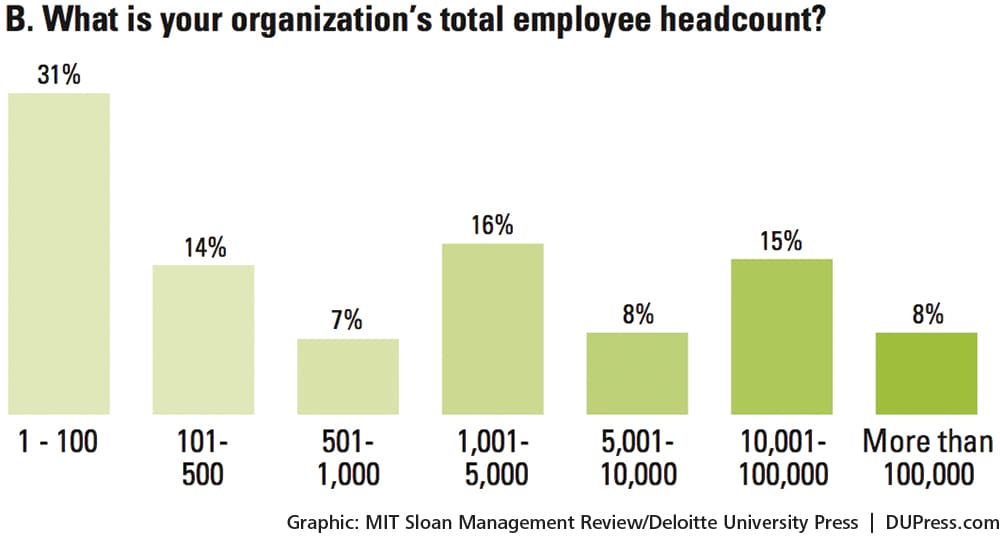
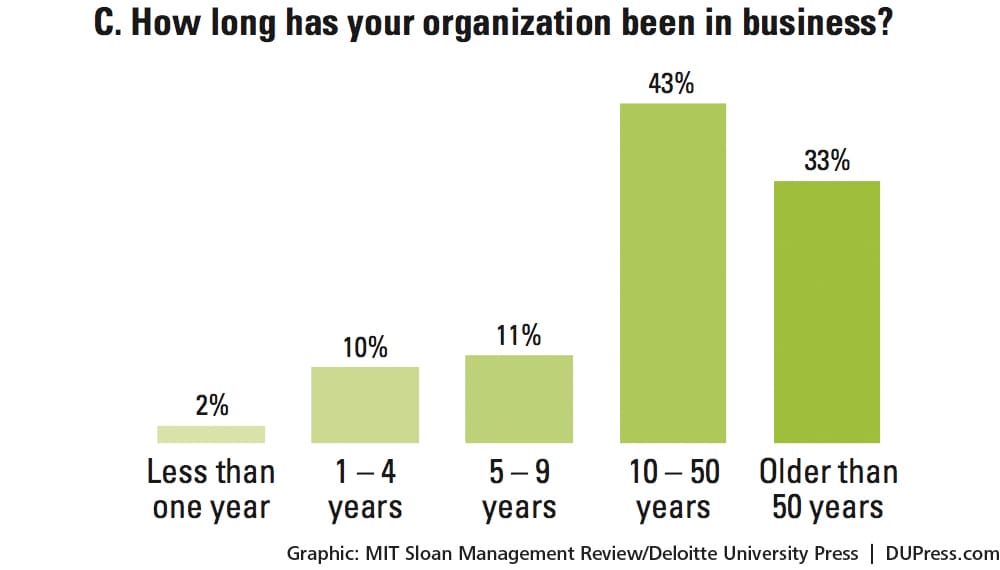
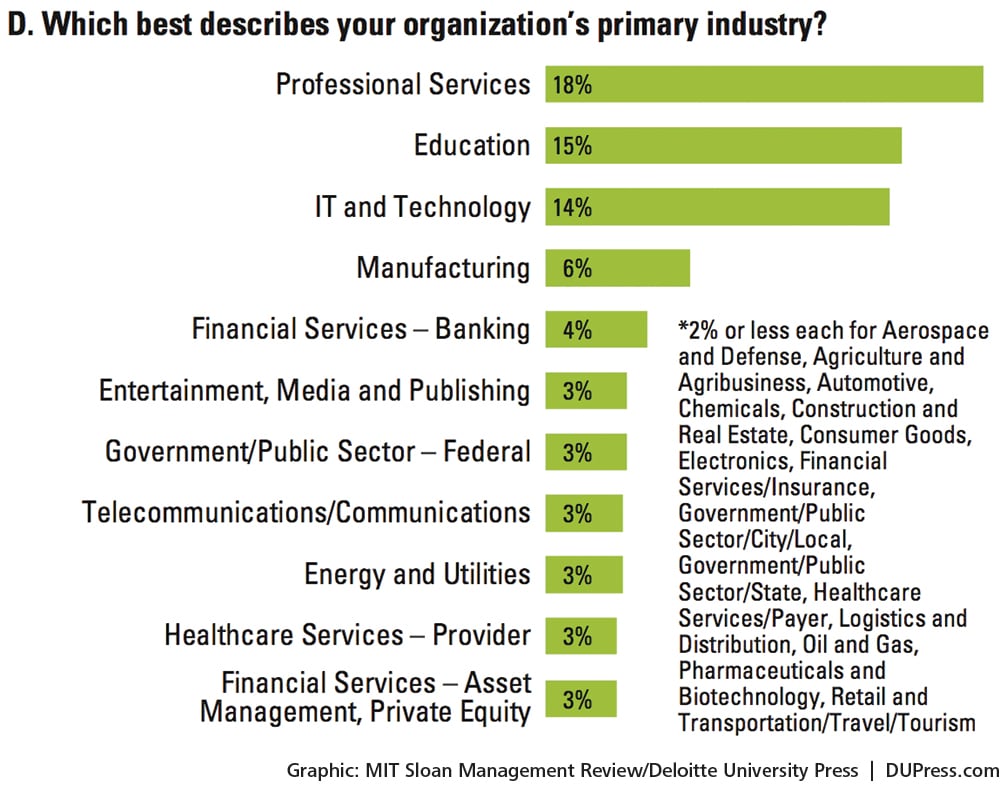
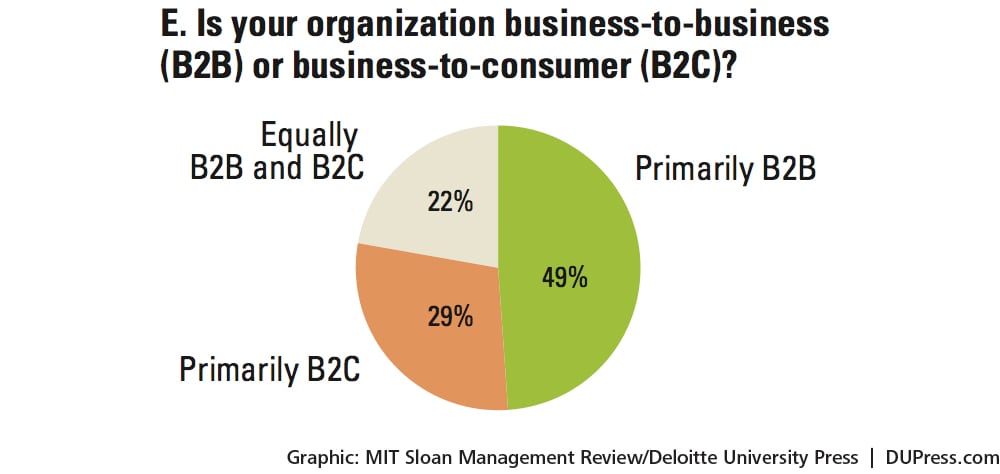
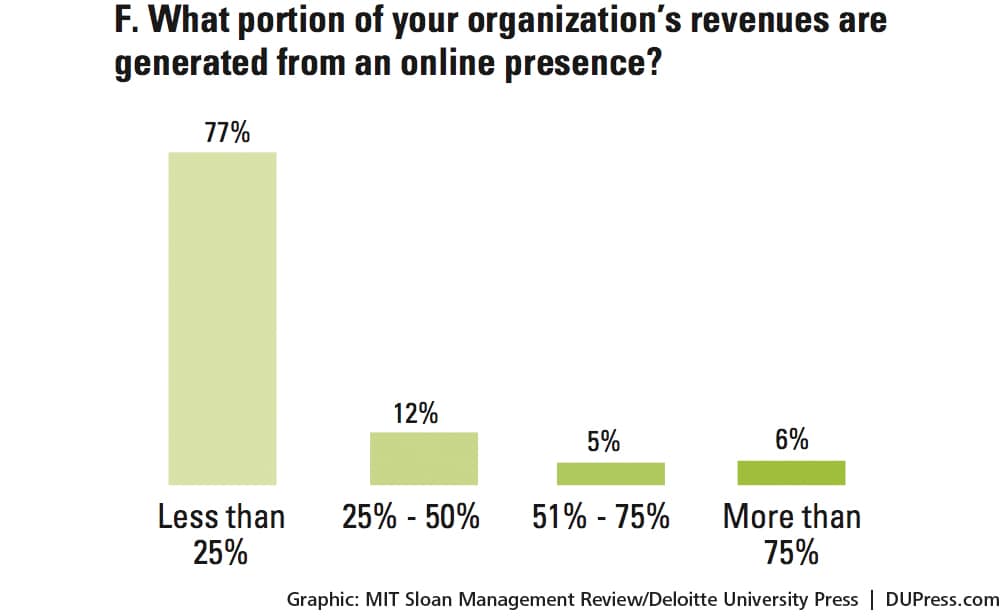
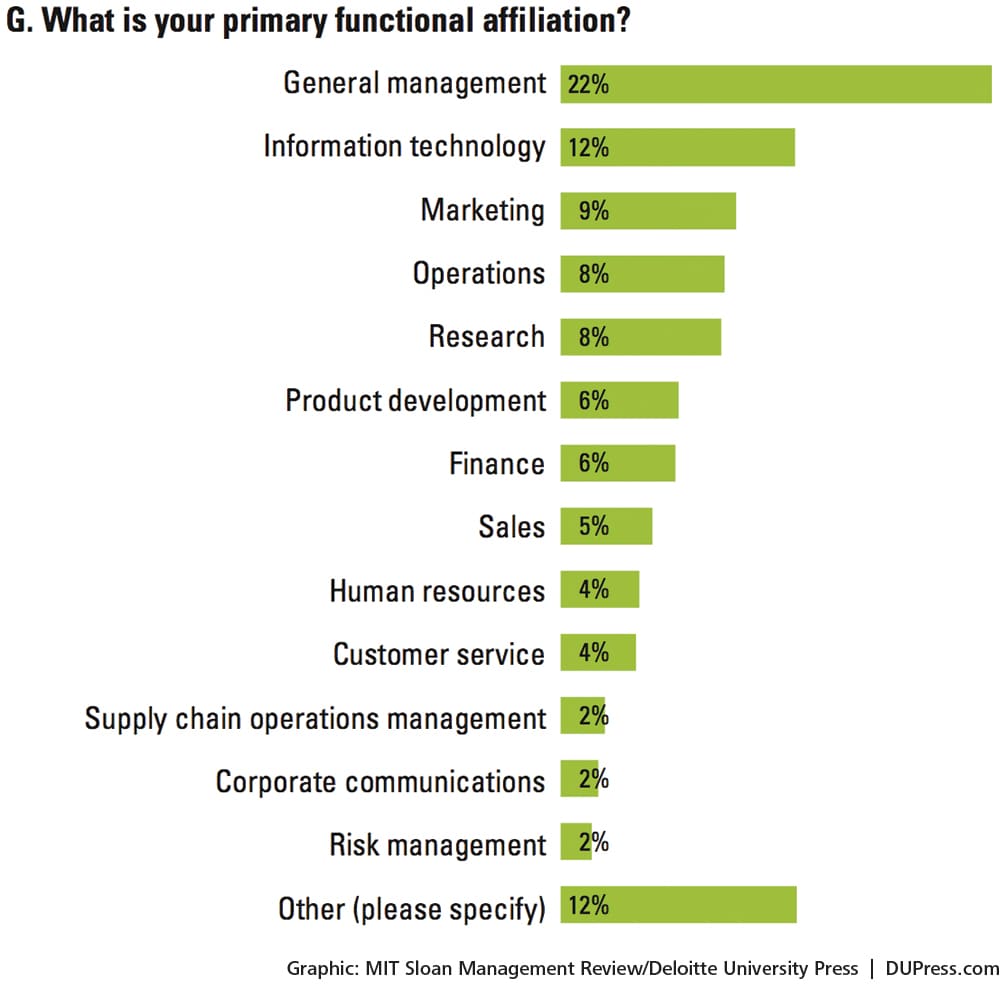
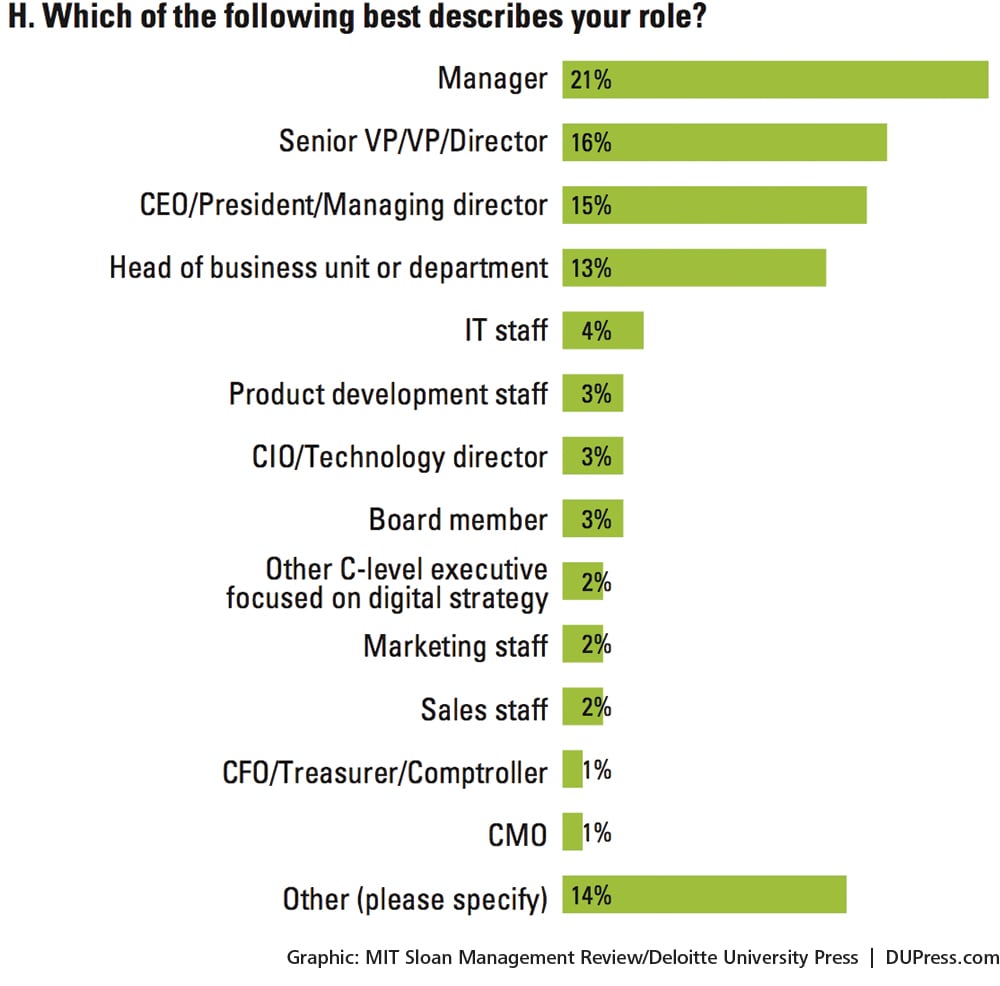
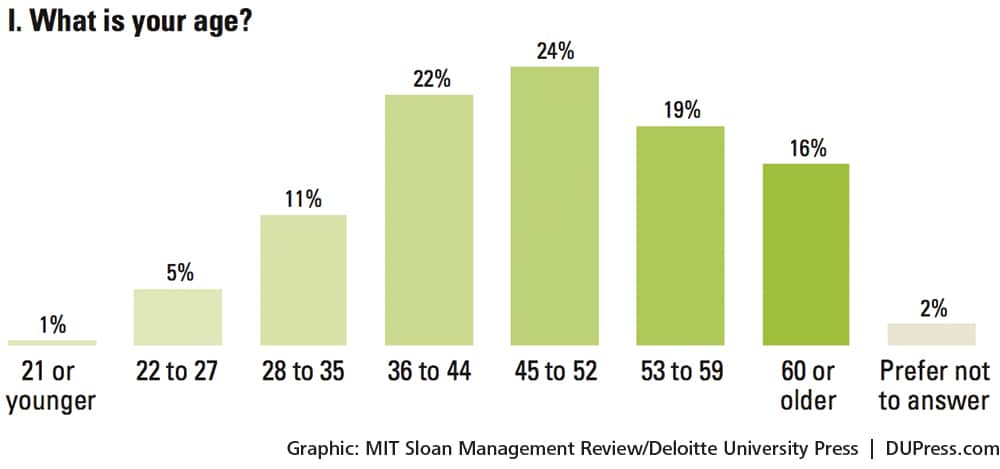
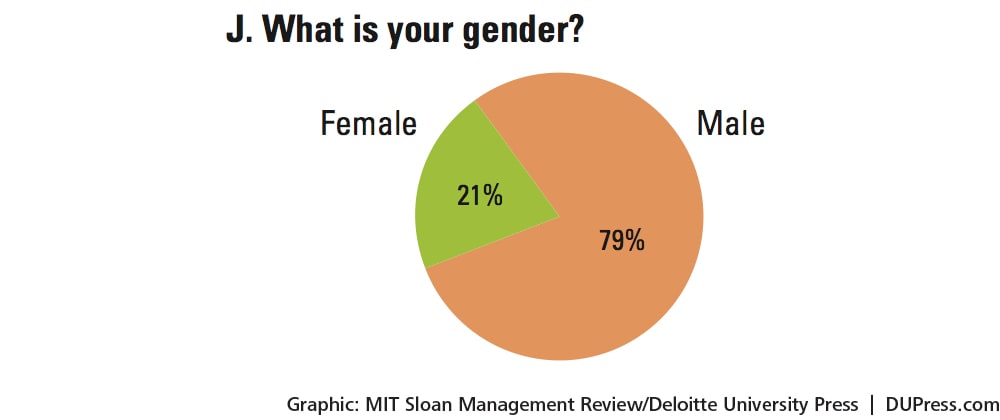
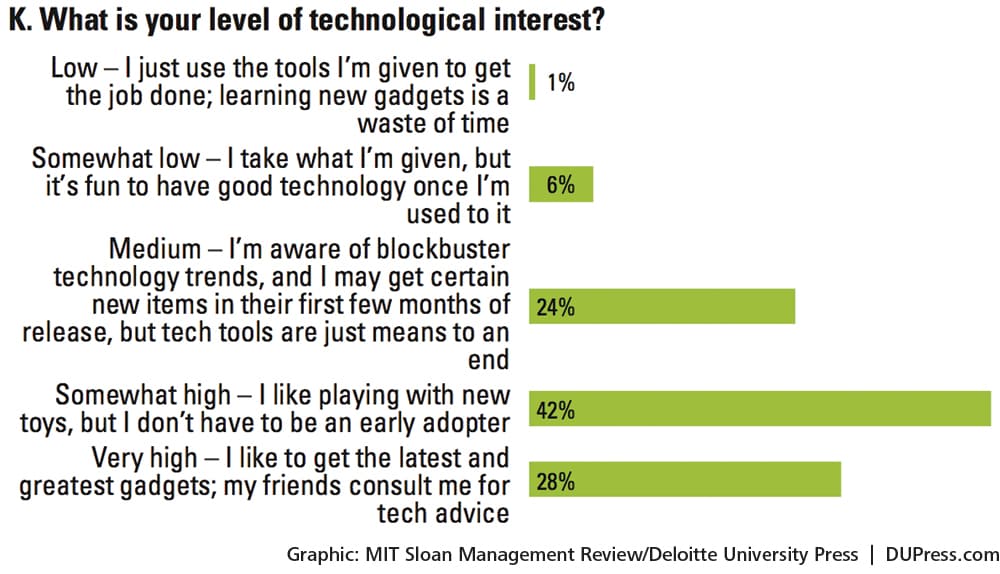
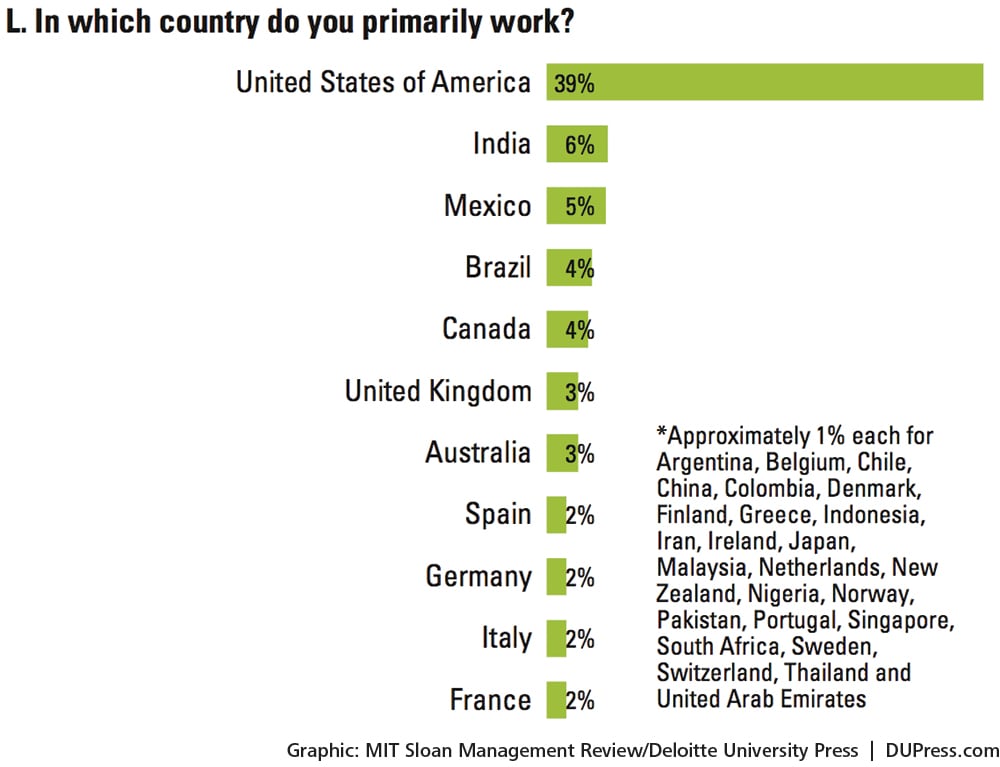
MIT Sloan Management Review
MIT Sloan Management Review leads the discourse among academic researchers, business executives and other influential thought leaders about advances in management practice that are transforming how people lead and innovate. MIT SMR disseminates new management research and innovative ideas so that thoughtful executives can capitalize on the opportunities generated by rapid organizational, technological and societal change.
Note: Apple Pay and Apple Watch are trademarks of Apple Inc. This publication is an independent publication and has not been authorized, sponsored, or otherwise approved by Apple Inc.















